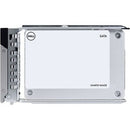Description
Upgrade your Dell ecosystem with a purpose-built internal solid-state drive that combines massive capacity, cutting-edge NVMe performance, and rugged reliability. The Dell D7-P5500 1.92 TB Rugged Solid State Drive is designed for data-intensive environments where fast access to large datasets is essential. Built to work with Dell servers and storage backplanes, this U.2 2.5-inch internal SSD leverages PCIe NVMe 4.0 to deliver high-throughput and low latency, enabling faster boot times, accelerated database queries, and smoother handling of virtualization, analytics, and media workflows. As a read-intensive drive, it prioritizes sustained read performance and predictable I/O under heavy workloads, making it a strong fit for big data analytics, content repositories, and read-heavy enterprise applications. The rugged design and enterprise-grade firmware provide reliability in demanding operating conditions, while seamless integration with Dell management tools keeps firmware updates, health monitoring, and serviceability straightforward for IT teams. If you need a high-capacity, high-performance, and dependable internal SSD that plugs directly into Dell systems, the D7-P5500 is engineered to deliver.
- Massive capacity for data-rich workloads: With 1.92 terabytes of storage, you can consolidate catalogs, databases, media libraries, and virtual machine images in a single device. This generous capacity reduces the need for frequent expansions and lets you scale your Dell infrastructure to meet evolving business demands while preserving performance.
- PCIe NVMe 4.0 performance for fast data access: Exploiting the power of PCI Express 4.0 and NVMe, the D7-P5500 delivers high sequential throughput and strong random read performance. This translates to faster data retrieval, responsive analytics, quicker file operations, and an improved user experience across enterprise applications and virtualized environments.
- Internal U.2 form factor for seamless integration: Designed as an internal U.2 (SFF-8639) drive, it fits neatly into Dell servers and other compatible enterprise systems. The U.2 interface supports robust hot-swap backplanes on many Dell configurations, enabling maintenance without disrupting critical workloads when chassis and backplanes support it.
- Optimized for read-intensive workloads: Built to excel in read-centric scenarios, this drive emphasizes stable read throughput, low latency, and consistent performance under sustained load. Ideal for large databases, content repositories, streaming workflows, and read-heavy virtualization tasks where predictable response times matter.
- Enterprise reliability with Dell ecosystem compatibility: Dell-branded storage devices pair with Dell OpenManage and firmware update channels, making management, monitoring, and warranty support straightforward. Designed for data centers and remote locations, the D7-P5500 provides a dependable foundation for Dell-based deployments with predictable support pathways.
Technical Details of Dell D7-P5500 1.92 TB Rugged Solid State Drive
- Capacity: 1.92 TB
- Interface: PCIe NVMe 4.0 x4
- Form Factor: Internal U.2 (2.5-inch) drive
- Drive Type: Read-Intensive NVMe SSD
- Target Workload: Optimized for read-heavy enterprise applications and data-center use
How to install Dell D7-P5500 1.92 TB Rugged SSD
- 1) Power down your Dell system and disconnect all power sources. Ensure you follow your data center’s lockout/tagout procedures and anti-static guidelines before handling any internal components.
- 2) Remove the server or workstation access panel to reveal the drive bays. Identify an available U.2 (SFF-8639) slot that supports 2.5-inch internal SSDs and is compatible with your Dell chassis backplane.
- 3) Align the Dell D7-P5500 with the U.2 connector and gently seat the drive into the drive bay. Secure the drive with the appropriate screws to ensure stable operation and prevent vibration in rack-mounted environments.
- 4) Connect the U.2 data and power interface to the backplane or controller. Make sure the cable routing avoids sharp edges and provides adequate ventilation to maintain thermal performance in dense enclosures.
- 5) Reassemble the chassis, reconnect power, and boot the system. Enter the system’s BIOS/UEFI to confirm the drive is detected. Some Dell systems may require a controller or firmware update for optimal NVMe compatibility.
- 6) In your operating system, initialize or format the new drive if required, and configure it for your workload. Use Dell OpenManage or your preferred management tooling to monitor health, firmware status, and S.M.A.R.T. data.
- 7) Update the drive firmware if a newer version is available to ensure compatibility with the latest Dell server features and security improvements.
Frequently asked questions
-
Q: Is the Dell D7-P5500 compatible with Dell PowerEdge servers?
A: Yes. The drive is designed for integration with Dell servers and backplanes, enabling straightforward deployment in Dell-based data centers and workstations. Check your chassis compatibility and backplane support for U.2 NVMe drives. -
Q: What workloads is this drive best suited for?
A: The D7-P5500 is a read-intensive NVMe SSD, making it well suited for workloads that require fast, reliable reads. Examples include large-scale databases with heavy read operations, media asset libraries, analytics data repositories, file catalogs, and read-heavy virtualization scenarios. -
Q: How does the rugged design benefit enterprise environments?
A: The rugged build helps withstand the operational realities of data centers, enterprise racks, and field deployments where vibration, heat, and power variability can affect performance. The combination of enterprise-grade firmware and Dell management support contributes to consistent reliability under demanding conditions. -
Q: Can I hot-swap this drive?
A: Hot-swap capabilities depend on the server backplane and chassis. In Dell configurations with hot-swap capable backplanes, the drive can be swapped with the system powered down to perform maintenance or capacity upgrades safely. Always follow vendor guidance for hot-swap procedures. -
Q: What management tools work with this drive?
A: Dell OpenManage and other Dell-supported management utilities can monitor health, performance, and firmware status. Dell-provided firmware updates ensure compatibility with current Dell servers, storage arrays, and support services.
Customer reviews
Showing - Of Reviews


